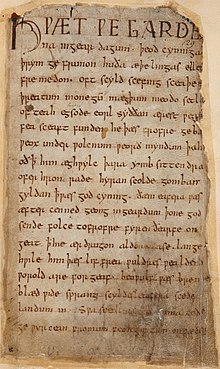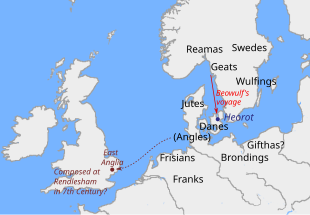
Beowulf is an Old English epic poem in the tradition of Germanic heroic legend consisting of 3,182 alliterative lines. It is one of the most important and most often translated works of Old English literature. The date of composition is a matter of contention among scholars; the only certain dating is for the manuscript, which was produced between 975 and 1025 AD. Scholars call the anonymous author the "Beowulf poet". The story is set in pagan Scandinavia in the 6th century. Beowulf, a hero of the Geats, comes to the aid of Hrothgar, the king of the Danes, whose mead hall Heorot has been under attack by the monster Grendel for twelve years. After Beowulf slays him, Grendel's mother takes revenge and is in turn defeated. Victorious, Beowulf goes home to Geatland and becomes king of the Geats. Fifty years later, Beowulf defeats a dragon, but is mortally wounded in the battle. After his death, his attendants cremate his body and erect a barrow on a headland in his memory.

Grendel is a character in the Anglo-Saxon epic poem Beowulf. He is one of the poem's three antagonists, all aligned in opposition against the protagonist Beowulf. He is referred to as both an eoten and a þyrs, types of beings from wider Germanic mythology. He is also described as a descendant of the Biblical Cain and "a creature of darkness, exiled from happiness and accursed of God, the destroyer and devourer of our human kind." He is usually depicted as a monster or a giant, although his status as a monster, giant, or other form of supernatural being is not clearly described in the poem and thus remains the subject of scholarly debate. The character of Grendel and his role in the story of Beowulf have been subject to numerous reinterpretations and re-imaginings. Grendel is feared by all in Heorot but Beowulf, who kills both him and his mother.

Lejre is a railway town, with a population of 3,097, in Lejre Municipality on the island of Zealand in east Denmark. It belongs to Region Zealand. The town's Old Norse name was Hleiðr or Hleiðargarðr.

Hrólfr Kraki, Hroðulf, Rolfo, Roluo, Rolf Krage was a semi-legendary Danish king who appears in both Anglo-Saxon and Scandinavian tradition.
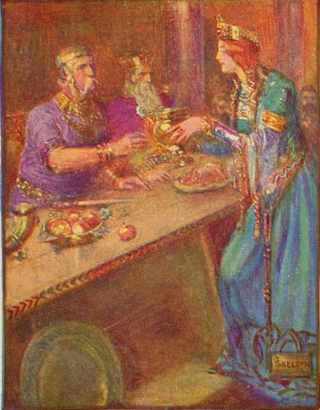
Hrothgar was a semi-legendary Danish king living around the early sixth century AD.
Hrunting was a sword given to Beowulf by Unferth in the ancient Old English epic poem Beowulf. Beowulf used it in battle against Grendel's mother.
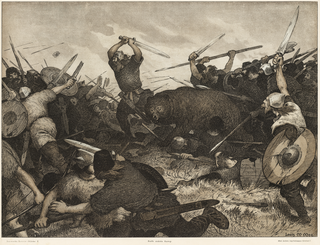
Bödvar Bjarki, meaning 'Warlike Little-Bear', is the hero appearing in tales of Hrólfr Kraki in the Hrólfs saga kraka, in the Latin epitome to the lost Skjöldunga saga, and as Biarco in Saxo Grammaticus' Gesta Danorum. He is often depicted with the ability to shapeshift into a bear.
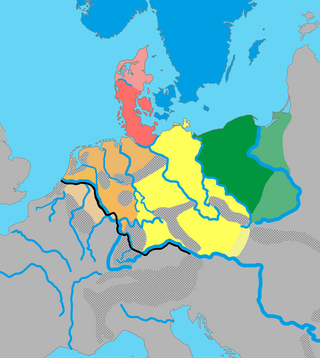
The Ingaevones were a Germanic cultural group living in the Northern Germania along the North Sea coast in the areas of Jutland, Holstein, and Lower Saxony in classical antiquity. Tribes in this area included the Angles, Chauci, Saxons, and Jutes.

Wealhtheow is a queen of the Danes in the Old English poem, Beowulf, first introduced in line 612.

"Beowulf: The Monsters and the Critics" was a 1936 lecture given by J. R. R. Tolkien on literary criticism on the Old English heroic epic poem Beowulf. It was first published as a paper in the Proceedings of the British Academy, and has since been reprinted in many collections.

In the Old English epic poem Beowulf, Unferth or Hunferth is a thegn of the Danish lord Hrothgar. He appears five times in the poem — four times by the name 'Hunferð' and once by the appellation "the son of Eclafes". The name Unferth does not appear in any Old English manuscript outside of the Nowell Codex, which contains Beowulf, and the meaning of the name is disputed. Several scholarly theories about Unferth have been proposed. Unferth is also the name of a character in the modern novel Grendel by John Gardner, based upon the Beowulf epic.

In Germanic mythology, an idis is a divine female being. Idis is cognate to Old High German itis and Old English ides, meaning 'well-respected and dignified woman.' Connections have been assumed or theorized between the idisi and the North Germanic dísir; female beings associated with fate, as well as the amended place name Idistaviso.
Ealuscerwen is an Old English hapax legomenon found in Beowulf . Since it appears to refer to a part of Anglo-Saxon drinking ritual, it has commanded a lot of scholarly attention.

The final act of the Anglo-Saxon poem Beowulf includes Beowulf's fight with a dragon, the third monster he encounters in the epic. On his return from Heorot, where he killed Grendel and Grendel's mother, Beowulf becomes king of the Geats and rules wisely for fifty years until a slave awakens and angers a dragon by stealing a jewelled cup from its lair. When the angry dragon mercilessly burns the Geats' homes and lands, Beowulf decides to fight and kill the monster personally. He and his thanes climb to the dragon's lair where, upon seeing the beast, the thanes flee in terror, leaving only Wiglaf to battle at Beowulf's side. When the dragon wounds Beowulf fatally, Wiglaf attacks it with his sword, and Beowulf kills it with his dagger.

Beowulf: A Translation and Commentary is a prose translation of the early medieval epic poem Beowulf from Old English to modern English. Translated by J. R. R. Tolkien from 1920 to 1926, it was edited by Tolkien's son Christopher and published posthumously in May 2014 by HarperCollins.

The Gevninge helmet fragment is the dexter eyepiece of a helmet from the Viking Age or end of the Nordic Iron Age. It was found in 2000 during the excavation of a Viking farmstead in Gevninge, near Lejre, Denmark. The fragment is moulded from bronze and gilded, and consists of a stylised eyebrow with eyelashes above an oval opening. There are three holes at the top and bottom of the fragment to affix the eyepiece to a helmet. The fragment is significant as rare evidence of contemporaneous helmets, and also for its discovery in Gevninge, an outpost that is possibly connected to the Anglo-Saxon epic Beowulf. It has been in the collection of the Lejre Museum since its discovery, and has been exhibited internationally as part of a travelling exhibition on Vikings.
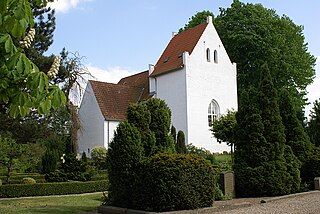
Gevninge is a village, with a population of 1,652, in Lejre Municipality on the island of Zealand in Denmark. Its old section is located alongside a small river, Lejre Å, approximately 2 kilometres (1.2 mi) from its mouth at Roskilde Fjord.
J. R. R. Tolkien, a fantasy author and professional philologist, drew on the Old English poem Beowulf for multiple aspects of his Middle-earth legendarium, alongside other influences. He used elements such as names, monsters, and the structure of society in a heroic age. He emulated its style, creating an impression of depth and adopting an elegiac tone. Tolkien admired the way that Beowulf, written by a Christian looking back at a pagan past, just as he was, embodied a "large symbolism" without ever becoming allegorical. He worked to echo the symbolism of life's road and individual heroism in The Lord of the Rings.
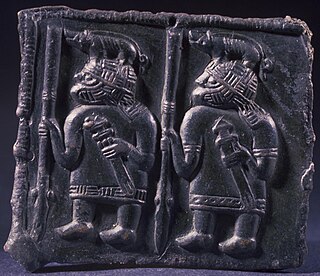
Germanic boar helmets or boar crested helmets are attested in archaeological finds from England, Denmark and Sweden, dating to Vendel and Anglo-Saxon periods, and Old English and Old Norse written sources. They consist of helmets decorated with either a boar crest or other boar imagery that was believed to offer protection in battle to the wearer. They have also been proposed to be a costume for the ritual transformation into a boar, similar to berserkers, and to be associated with Freyr.
